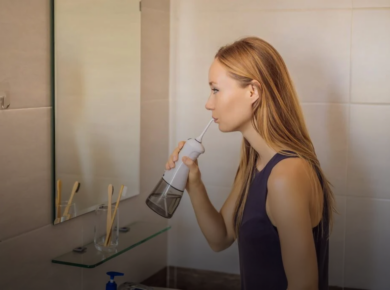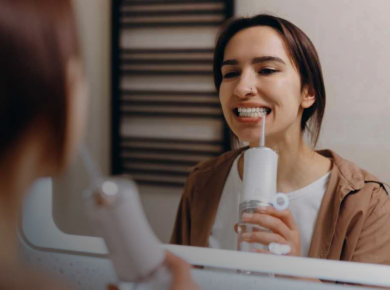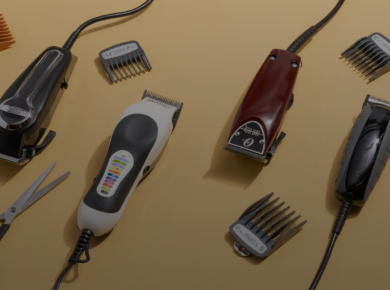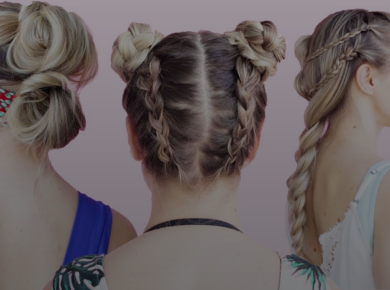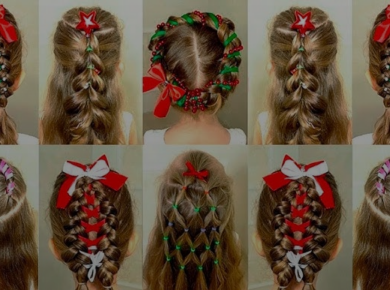There are different types of hair dryers on the market, with various manufacturers, features, and attachments. When choosing a product for your hair type, you need to understand all these details. This is necessary to ensure proper hair care, make styling easier, or even for efficient professional use of the device.

Difference Between Hair Dryer and Blow Dryer
Let’s clarify the terms from the start to avoid confusion. So, a blow dryer is usually a professional tool used in hair salons, barber shops, etc. The term “hair dryer” is more commonly used for household models — these are devices for home use. You can use these terms interchangeably, but salon devices are generally more powerful, with more attachments and modes, allowing them to work with various hair types and lengths, thus enabling specific styles.
Hair Dryer Types
The main difference between hair dryers is their technical characteristics and the availability of additional options. Some technologies make it easier to work with porous and curly hair, while others work well with smooth and unruly hair. The choice between them depends on the goal you set for yourself: care, styling, etc.
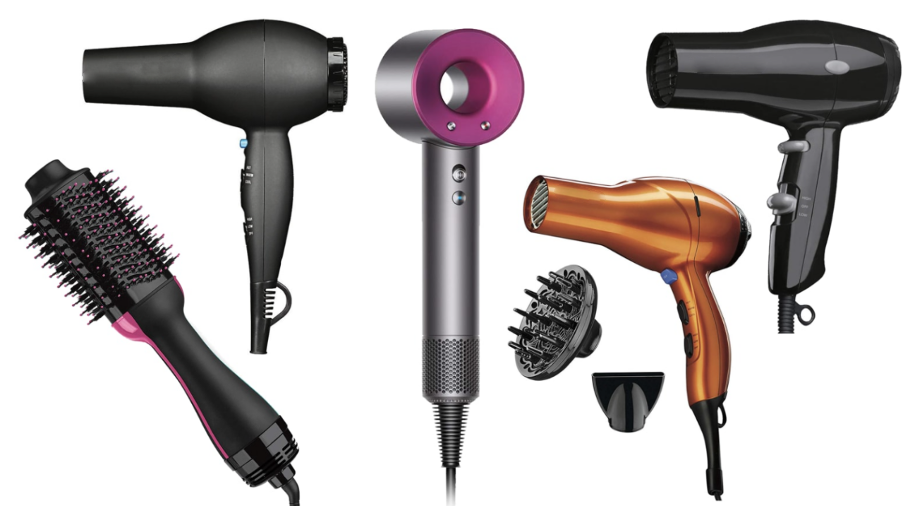
Ionic hair dryers
These devices are ideal for working with curly, thick, porous hair. They help tame the hair during drying, smooth it out, and add shine. Ionic dryers emit negative ions, making hair less prone to frizz and static. With these devices, hair dries with less heat but just as fast or even faster than in regular modes. Ionization doesn’t require the use of high temperatures, so you can work without applying heat protection sprays to your strands.
The main drawback of ionization is that the voluminous and fluffy hair you’re used to may look less voluminous, more straight, and flat after styling. Meanwhile, the key advantage is that the hair cuticle doesn’t open, so the hair retains moisture better and remains healthy. This mode is highly recommended by hairdressers to clients whose hair is prone to breakage, especially when they want to grow long hair without constantly trimming split ends. Over time, the hair becomes thicker and looks healthier. A split hair shaft typically splits down to the follicle and eventually falls out. Less hair loss means more volume.

Ceramic hair dryers
When defining the best type of hair dryer, the ceramic dryer can be included in this category. This device is coated internally with a ceramic layer that distributes heat evenly. Additionally, a heat sensor allows these models to regulate the temperature so that the air is neither too cold nor too hot. The optimal temperature mode ensures gentle care for the hair without damaging it. This is crucial if you’re looking for a device for regular home use and care about your hair’s health.
These types of blow dryers are recommended for all hair types, making them a versatile device that gently treats your strands without harming them. This is the main advantage. The only typical drawback of such models is the longer drying time. Therefore, in salon conditions or when you’re in a hurry, it may be easier to work with other types of dryers.
Tourmaline hair dryers
The working principle of tourmaline models is similar to that of ionic devices, but there is a difference. These dryers emit negative ions and use infrared heating for gentle drying.
They are the perfect solution for those with thick, porous, or long hair. These models are also recommended for people with curly strands, especially those that are hard to comb after drying, making the drying and styling process crucial.
Tourmaline technology ensures fast drying, healthy shine, thorough care, and high-speed operation. These are some of the best (but also most expensive) options available on the market.
Titanium models
When considering different types of hairdryers and looking for solutions suitable for salons, pay attention to titanium models. They are extremely powerful, allowing for high-speed and efficient work, and are resistant to overheating. These models can last for many years without losing relevance. Another significant advantage for professional use is the lightweight body, so your hands don’t get tired from holding the device for extended periods. Another benefit is the uniform and efficient heat distribution and high-speed operation. The main and only drawback is the strong hot air flow that these models allow, which can damage fine and brittle hair. Therefore, these models are best for professional use, where the hairdresser can choose the best mode depending on the client’s hair condition.
Brush dryer
This model is designed to make life easier for those with hairstyles that require daily styling. Typically, styling requires a hairdryer and a brush. But a brush dryer combines both solutions, simplifying and speeding up this procedure many times over.
These models are perfect for home use and making daily hair care routines easier. Moreover, the brush allows you to create beautiful curls and straighten your hair. You can easily use it instead of a curling iron or flat iron. Additionally, the brush makes it easy to achieve the desired root volume. Brush attachments can be thicker or thinner, and, accordingly, the diameter of the curl you get when curling with the brush can also be adjusted.
In its primary role — drying the hair — the brush dryer also performs perfectly. So, you can buy one high-quality and powerful device instead of three and save money.
The Most Common Hair Dryer Attachments
The functionality of a hair dryer largely depends on the attachments used with it. The main variations include:
- Diffuser. It is an attachment with “finger-like” nozzles that help create beautiful natural curls. It’s an ideal solution for curly and porous hair. The difference between diffuser and hair dryer is in the form of this attachment.
- Concentrator. A classic nozzle that provides a precise and directed airflow, allowing you to control the direction of the air as needed. This is a universal attachment that suits every user.

Key Technical Specifications to Consider When Choosing
Each of the above-described types of hair dryers is available in different price ranges and with varying technical features.

Power
Voltage directly affects how powerful the dryer can be, i.e., the maximum airspeed and temperature available. Even if you don’t need a super-powerful device, it’s best to opt for higher voltage since models with higher voltage typically have better durability. They are designed with heat-resistant components and sensors for long periods of continuous operation. An optimal range is 1800W to 2000W.
Heat Settings
It’s more convenient to work with a device that has several airflow speed and heat settings. More expensive models allow you to precisely set the temperature, while others offer switches between slightly warm, moderate, and hot air, or even an ionization mode. It’s also beneficial to have settings that let you switch between weaker and stronger airflow.
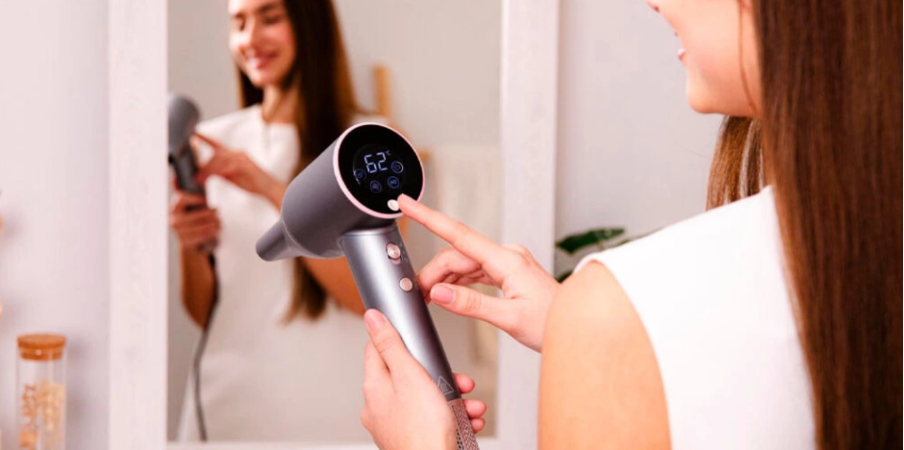
Cool Shot Button
If you want to protect your hair from the negative effects of high temperatures or close the hair cuticles when finishing the drying process, this button will be useful.
Weight and Comfort
If you work in a salon or use the dryer professionally, or if you have long or thick hair, pay attention to the weight of the model and how comfortable it feels in your hand. This will determine whether it’s comfortable for styling or prolonged use throughout the day. Test the options before you buy.
How to Choose the Best Type of Hair Dryer for Your Hair
Some recommendations on which types of hair dryers are best suited for different hair types were mentioned above. Now, let’s dive deeper into how to use this as a guide when choosing a hair dryer, as it’s extremely important.
Thin Hair
Those with fine, smooth, or fragile hair should opt for dryers with ionic or ceramic technology to preserve shine and effectively dry the strands while sealing the cuticles. Ceramic technology helps distribute heat evenly and prevents damage to thin strands. Meanwhile, an ionization mode is ideal for weak, thin, damaged, or colored hair, as it protects the structure. In such a mode, ionization helps close the cuticles and removes excess moisture between the strands, which can otherwise lead to dandruff or other negative consequences.
For colored thin hair, this becomes a lifesaver. The pigment in hair can react to different temperatures, and using high heat settings may result in more frequent visits to your hairstylist or colorist.
Thick Hair
Thick hair is harder to manage, so it’s best to choose a model with high power — 2000W or more — to speed up the drying process. A low-powered dryer might take 30 minutes or longer to dry thick or long hair. Hairdressers also recommend choosing models with an ionization mode to prevent damage from constant high-temperature exposure.
If thick hair tends to be curly or highly porous, it requires special care, and a tourmaline dryer would be the perfect choice in this case. Choosing such models simplifies and speeds up the drying process while providing proper care for your hair.
Curly or Porous Hair
Working with curly hair is similar to drying thick and porous hair, as it also takes longer to dry and is difficult to comb. If you have natural curls, the best thing you can do is preserve the natural shape of each curl. To do this, choose a powerful dryer with a diffuser attachment. Opt for a diffuser with dense prongs, which will make it easier and more effective to set each curl in place. It’s also recommended to have a dryer with multiple temperature and speed settings for gentle use.
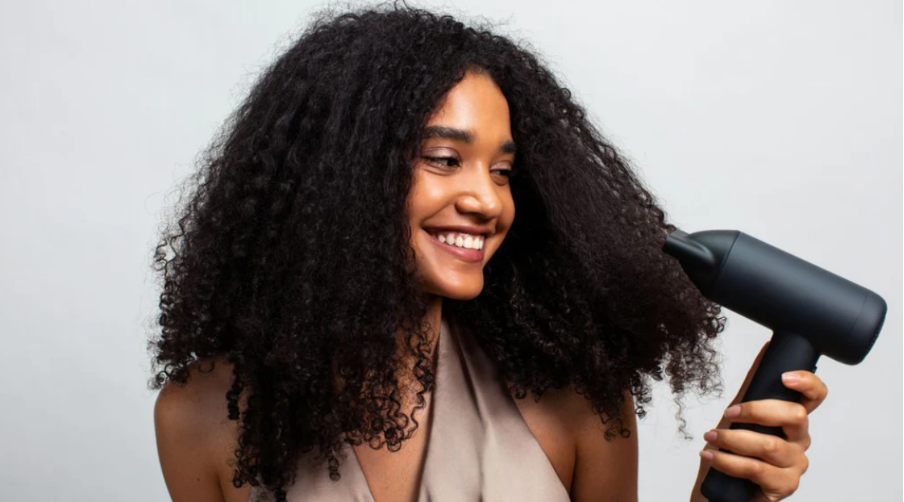
Damaged and Dull Hair Lacking Shine
The best and most effective solution for working with dull and colored hair is to use an ionic hair dryer. These help dry strands gently while closing the cuticles, resulting in a healthy shine.
You may also need to experiment to find the right balance between drying speed and care. Choose a dryer with adjustable airflow speed, allowing you to use a stronger airflow of cooler air instead of additional heat, thus drying your hair without damaging it.
How to Dry Your Hair to Achieve the Desired Result
Choosing the right hair dryer model is not enough. Here are some tips that will help you use this tool as professionally as a hairstylist:
Use Heat Protection
Heat protection products form an invisible layer around your hair, protecting its structure from damage. Heat protectants also help reduce static electricity. If you want to avoid your hair sticking to your hat when you remove it, turning you into a “dandelion,” always use heat protection.
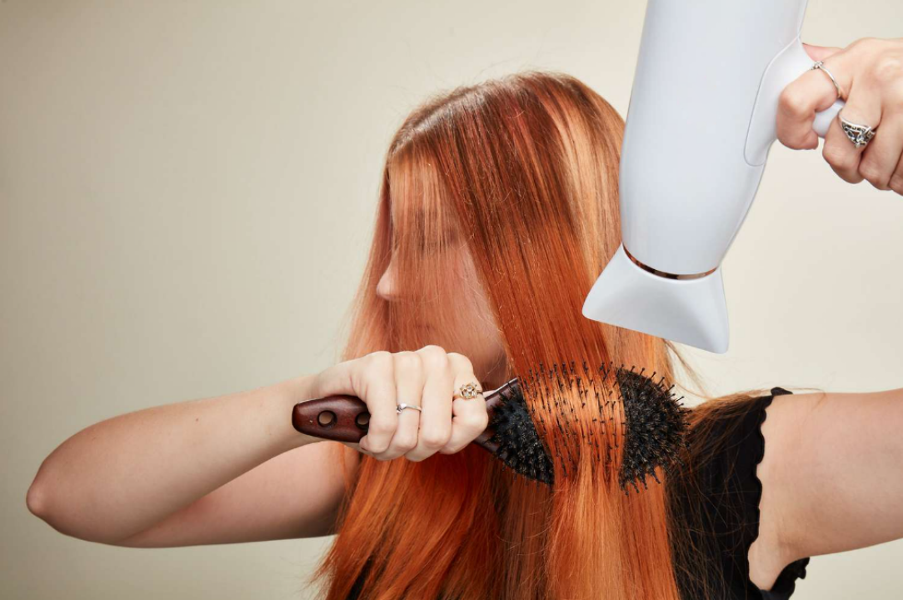
Have Several Brushes for Styling and Drying
A round brush helps create volume, a vented brush helps easily dry the length, and a fine-toothed comb with a pointed end is the best tool for dividing hair into separate sections, making it easier to work with. Gradually reduce the air temperature as your hair dries. This ensures that you don’t over-dry or “fry” it. In the final minutes, you can even turn off the heat and use the ionization mode if your tool has it.
First, Pat Your Hair Dry with a Towel
Under the influence of hot air, moisture evaporates quickly, which isn’t ideal for your hair. It’s better to allow a soft towel to absorb the excess moisture first before moving on to drying.
Always Section Your Hair
This will make it easier to work with even long or thick hair. Start drying from the top down, holding the dryer at about a 45-degree angle. This way, the airflow will be directed optimally to close the cuticle scales. Drying all your hair at once with your head bent down may seem appealing because it’s fast. But don’t do it. This damages your hairstyle as the cuticle scales open even more, leading to breakage, frizz, and dullness.
A good approach is to gradually move from strand to strand without spending too long on each one. Work with one section, then move on to the next. Ensure the dryer isn’t too close to your hair.
Summing Up
It depends on your hair type and needs, so choosing one model of a hair dryer or another is based on those factors.
Some important takeaways for you:
- Countless models of hair dryers come with specific features for different hair types.
- Ionic, ceramic, and tourmaline technologies are the most popular and useful. Ionic dryers reduce frizz and preserve moisture, ceramic dryers distribute heat evenly and help in drying delicately, and tourmaline dryers shoot infrared heat, hence are best suited for thick or curly hair.
- The most versatile and safer for everyday use would be hair dryers that possess several heat and speed settings.
- The higher the wattage of a dryer, the faster the process of drying and the more durable the tool.
- Diffusers and concentrators are your best friends when working with different hair types.
- Choose a hair dryer based on hair type. It is the best solution.
All of these tips will help you find the ideal hair dryer for your hair type and take proper care of it. You can also enhance your knowledge by reading reviews on specific models to find the perfect tool!
Want to BUY this product?
Check out retailer list for your country.


